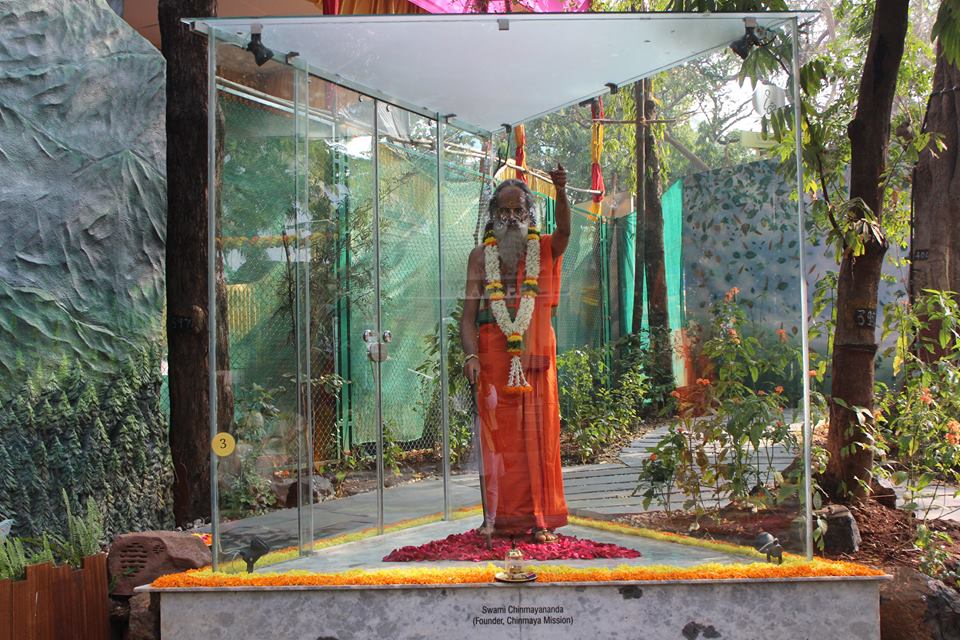Relevance of the Bhagavadgita to Humanity : 17.4 - Swami Krishnananda
=================================================
.
Chinmaya Pradeep re-opened on 16th January 2017
Chinmaya Pradeep re-opened on 16th January 2017 - the 60th Aradhana day of Paramguru Poojya Swami Tapovanji Maharaj. Poojya Guruji Swami Tejomayanandaji, Swami Swaroopanandaji and other acharyas re-opened Chinmaya Pradeep, offering flowers at Poojya Gurudev Swami Chinmayanandaji's Pratima, offering water from Tirthraj Prayag into the rivulet at Pradeep, offering prayers to Poojya Swami Tapovanji Maharaj and concluding with Poojya Gurudev Swami Chinmayanandaji's aarti in His Kutia. Everyone is welcome to visit Chinmaya Pradeep Mon-Sun 7am to 11am and 4pm to 8pm(except Wednesdays). We thank all the volunteers and everyone involved in the repairs and renovation as well as the reopening programme.
==================================================
Monday, January 10,2022. 7:00. PM.
Chapter 17: The Meaning and Purpose of Sacrifice : - 4.
(The First Six Chapters of the Bhagavadgita )
(Spoken on Bhagavadgita Jayanti).
==================================================
So a person is free who is capable of doing action as a sacrifice. What is this sacrifice? Though we have gone into the analysis of this matter, the final word about it is now said in a single verse. Brahm?rpa?a? brahma havir brahm?gnau brahma?? hutam, brahmaiva tena gantavya? brahmakarmasam?dhin?: The wave in the ocean is the ocean. Another wave in the ocean which collides with this wave is also the ocean. The force that compels one wave to collide with another wave is also the force of the ocean. The end result of the coming together of two waves in the colliding of two waves is also the ocean. The rising of the waves is the activity of the ocean. The subsiding of the waves is also the activity of the ocean. Everything is the single body of this one substance called the ocean.
The performer of the action is not you, is not me, is not anybody. It is so because the performer is the psychophysical organism, normally speaking, but we have now understood that neither the psyche nor the body is anybody's property. It is a borrowed value, as it were. It is part of all things in this world. Hence, it is something like all the bricks in a building being shaken when one of them is shaken. Much more is the connection here than the connection of one brick with another. It is difficult to analogically explain what the circumstance is. Imagine that there is a living connection between one brick and another in this building. Actually, a living connection is not there between one brick and another; there is only a mechanical connection, but we have to imagine for the purpose of this context that there is life operating between one brick and another. If you shake one brick, naturally the whole building shakes, so the operation of a single brick is the operation of the whole building. Thus, the performer of the action is not any person, is not any individual, because the motive force for any action which is either the body or the mind, or both put together, comes from that of which the psyche and the body are made, that out of which everything else is also made, that which is the matrix of the cosmos. Therefore, you may say that any movement of any particular individual, any event that takes place anywhere, is the action of the whole universe.
The result that may follow from the performance of an action is also a redounding method, process, adopted by the very same performer, which is not you, which is not me. And the force that is responsible for the operation of this kind is also that very same matrix constituted of the three gunas. The offering, the offerer, the process of offering, the consequence of offering – all these are one single mass of operation. Therefore, there is no individual performer of an action. Hence, it is unbecoming on the part of anyone to expect the fruit of an action for one's own self. Here is the crux of the matter of the whole teaching of the Bhagavadgita. You cannot expect the fruit of an action, because the fruit is not the result of the performance of any particular individual. It is the total outcome of the exuberance of total action; therefore, in the same way as the action is not yours, the fruit also is not yours.
Now again, I come to the point. All these are hard nuts to crack. Our brains are not so made as to remember all these little things. This is the essence of this verse, brahm?rpa?a? brahma havir brahm?gnau brahma?? hutam, brahmaiva tena gantavya? brahmakarmasam?dhin?. In a ritualistic fashion, as it were, this verse is framed. The oblation is Brahman, the Absolute. The offerer of the oblation is the Absolute. The consequence, the result, the fruit, if any, is the Absolute. The entire process is the Absolute. And to make it a little homely, I brought the illustration of the ocean rumbling within itself. Every little shake of a ripple on the surface of the sea is due to the action of the very bowels of the whole ocean, and this illustration will give some idea as to how the cosmos acts.
Now, the great teacher becomes more and more realistic as he proceeds further. As a very good psychologist, a very good schoolmaster, he does not want to bore you with very tough teachings, metaphysical doctrines and scientific expositions. He comes to certain simple, intelligible and homely examples of right action, yajna, sacrifice, meditation, yoga.
To be continued ...
==================================================











Comments
Post a Comment